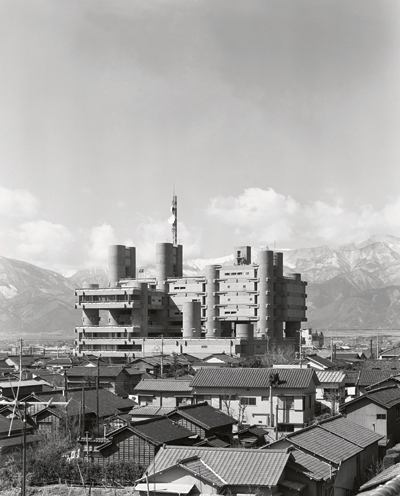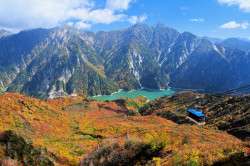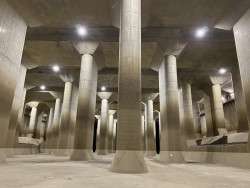
September 24, 2011
Deconstructing Tokyo
Get into architecture this fall, with a major symposium and related exhibitions
By Metropolis
Originally published on metropolis.co.jp on September 2011

Architectural happenings this fall
- UIA2011 Tokyo
The “Olympics of Architecture” is taking place in Tokyo for the first time ever, with an extensive program of English-language lectures, workshops and exhibitions. Hear about Czech modernist architecture and environmental design, witness student competition award-winners, and more. Tokyo International Forum, Sep 25-Oct 1 (listing). - Japan Home and Building Show
Realized in conjunction with UIA2011, this annual show will display cutting-edge products under the theme, “Traditional to Creative: Japan with the World.” Tokyo Big Sight East Hall, Sep 28-30 (listing). - World Architecture Festival Tokyo Preview
Quaff a glass at this free entry exhibition featuring Japanese and Asian entries to the WAF. RSVP required. Uchida Yoko showroom, Sep 26-28 (listing). - House Inside City Outside House: Tokyo Metabolizing
Explore full-scale houses inspired by the Metabolism movement. Tokyo Opera City Art Gallery, until Oct 2 (listing). - Architectural Environments for Tomorrow—New Spatial Practices in Architecture and Art
Introducing trends displayed at last year’s Venice Architecture Biennale, this exhibition focuses on young Tokyo architects, with activities including product and environmental design, both within and outside the museum. Museum of Contemporary Art Tokyo, Oct 29-Jan 15 (listing).

Few of us need reminding that Tokyo sits close to several major geological fault lines. The challenges this created in the past has been a major factor in shaping our city. For example, one reason most of the skyscrapers are located in Shinjuku is because this area is considered geologically more stable than the rest of the city.
In addition to its precarious geological situation, Tokyo also lies on a major fault line between different philosophies of architecture—Western and Eastern—that rub up against each other like major tectonic plates. The tension created by this “architectonic” pressure make Tokyo one of the most fascinating architectural cities in the world, something that should be particularly in evidence this month with a major architectural conference and several exhibitions in town.

Forming a centerpiece for all this architectural activity will be the World Congress of the UIA, the French acronym for the International Union of Architects, an international NGO that was founded in 1948 and which now represents over a million architects worldwide. Sometimes described as the “Olympics of Architecture,” the congress is held triennially in a major city and usually attracts around 10,000 architects, engineers, researchers, and students for a range of presentations, seminars, exhibitions, and tours.

Surprisingly this will be the first congress to be held in Japan and only the second in Asia. As in previous years, the congress will have a theme. While looking far ahead, this year’s theme—“DESIGN 2050: Beyond disasters, through Solidarity, towards Sustainability”—is also a clear reference to the Great East Japan Earthquake earlier this year.
By setting their sights on the distant future—in Tokyo, 39 years is an eternity—the organizers emphasize the Blade Runner-like modernism that many associate with our metropolis. However, key Japanese participants in the congress, like Kengo Kuma, the Chair of the Student Competition, and Fumihiko Maki, the Chair of the Japanese Advisory Board, prefer to emphasize the indigenous elements that underlie and mitigate such modernism.

“The uniqueness of Tokyo is that it is a series of villages,” Kuma explained in a recent interview at his Aoyama office promoting the Congress. He went on to highlight the small, wooden houses that remain in Aoyama despite its central location. Yet, even where the small, traditional Japanese house has been superceded by other methods of building, Kuma believes it has still left its imprint. “I think the small scale of much of the city comes from the scale of the wooden houses,” he said.
According to Kuma, Tokyo’s uniqueness also resides in the “contrast between quiet, sacred space and active, noisy commercial space.” The example of the bustling fashion street of Omotesando leading to the spiritual oasis of Meiji Shrine is perhaps the most famous.
Maki, for his part, attributes Tokyo’s architectonic variety to the destruction wrought by the Great Kanto Earthquake of 1923 and the debilitating US air raids of 1944-45. “In spite of these calamities,” he says, “some of the old buildings still remain, but in fairly fragmentary ways. But this mixture gives a certain charm to a city of this size.”

Tokyo’s ever-changing urban landscape has helped free the imaginations of architects, leading to radical, uninhibited thinking about our constructed environment. A major show at the Mori Art Museum takes a look at the revolutionary 1960s architectural movement Metabolism, which used the analogy of living organisms to conceive of buildings as flexible “organic” entities, able to adapt and adjust to changes in the environment and serve varying functions.
Including such luminaries as Kisho Kurokawa, Fumihiko Maki, Arata Isozaki, and one of Japan’s most famous architects Kenzo Tange, the movement’s typical proposals included a “sky city” of tall buildings connected by acrophobia-inducing walkways and a floating island city strung out across Tokyo Bay—neither of which seem exactly reassuring concepts in a land known for earthquakes and tsunamis.
Some of the grander Metabolist visions have a sci-fi feel to them, with the result that very few actual Metabolist buildings were commissioned—see Shimbashi’s Nakagin Capsule Hotel before its residents’ requests for it to be demolished come to fruition. Nevertheless, the movement continues to have a significant influence on contemporary Japanese architects like Toyo Ito, Kengo Kuma, and Tadao Ando, perhaps because the core idea of architectonic flexibility has its roots in the traditional Japanese house—adjustable to seasonal and diurnal variations through the use of shutters, blinds, and sliding doors.
A separate exhibition at the Miraikan (National Museum of Emerging Science and Innovation) shows some of the residual influence of the movement. “Making of Tokyo Sky Tree—Welcome to the construction site in the sky” showcases the work behind the nearly complete Tokyo Sky Tree that now looms over our city.
One of the innovative features of Tokyo’s new tallest building is its enormous underground water tanks. These allow the building to do its heating and cooling work, depending on the season, during the night when off-peak electricity rates are available, and then to store the water for temperature control during the day. It is estimated that this feature will save 40-50% in energy costs.
In many ways the Tokyo Sky Tree is the perfect embodiment of the city’s unique position on the geological and architectural fault lines. Constructing such a tall building in an earthquake zone raises particular safety issues. While the TST may be too tall and streamlined to really resemble a tree, underground it’s a different story. The building is literally rooted to the ground with pilings driven 50 meters into the ground that fan out in a radial fashion, rather like the roots of a tree.
Despite its modernist appearance, the building also owes a large debt to indigenous architectural traditions. The sway-reducing technology incorporated in the central shaft was partly inspired by Japan’s ancient pagodas, which have a particularly good track record in standing up to earthquake shocks. For example, since it was built, Nara’s Horyuji Temple pagoda has weathered around 1,400 years of tremors. Like these pagodas, the TST incorporates an independent central shaft designed to dissipate seismic forces. Under the shade of this remarkable structure, Tokyo is set for a fascinating architectural early autumn.

Click here for an exclusive Q&A with Mori Art museum Director, Fumio Nanjo.
Click here to see the Metropolis feature on Metabolist architect Yoji Watanabe.
Click here for some exclusive extracts from Tuttle’s new magnum opus, New Japan Architecture.







